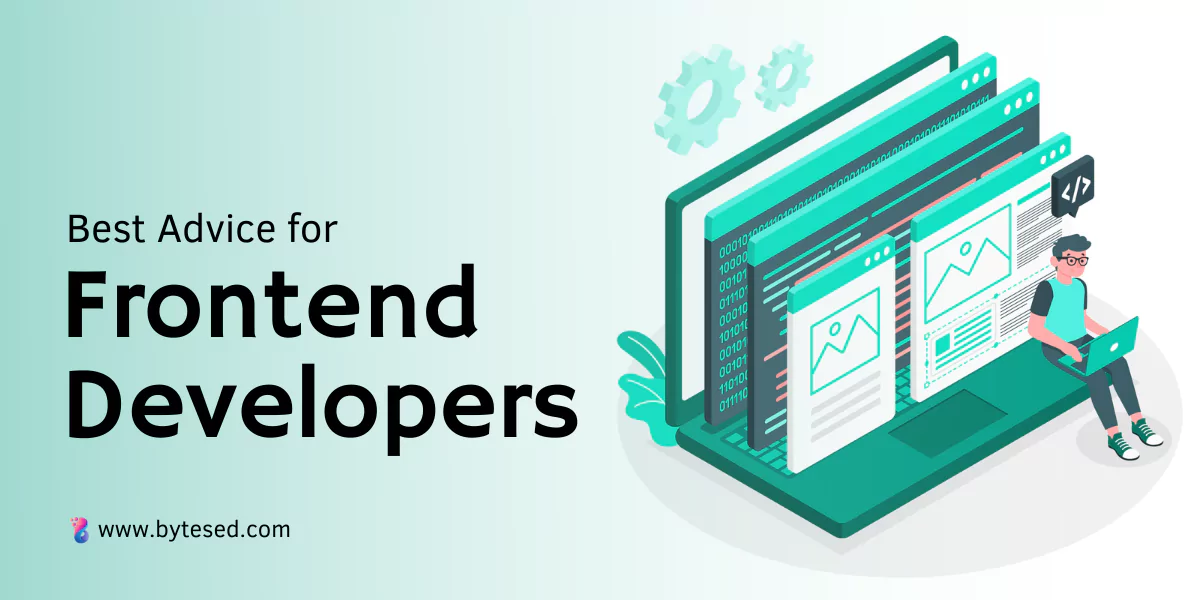
Welcome to the dynamic world of frontend development a realm where creativity intersects with logic, and user interactions come to life. Frontend developers are the artisans of the digital space, shaping the visual aspects of a website that engage and captivate users.
Recent statistics reveal a growing demand for this skill set. As per a report by the Bureau of Labor Statistics, the job market for web developers is expected to grow 13% from 2020 to 2030, a pace much faster than the average for all occupations. This surge demonstrates the critical role frontend developers play in our increasingly digital economy.
Our mission in this article is simple yet pivotal. We aim to equip you with invaluable advice, guiding principles, and tried-and-true practices to help you navigate your journey as a frontend developer. Whether you’re just stepping foot in this arena or looking to level up your game, this guide provides the insights you need to excel.
So, let’s embark on this journey together, shall we? Along the way, we’ll delve into the core technical skills you need to master, discuss the importance of a well-curated portfolio, and even touch on some often-overlooked soft skills.
We’ll explore the significance of understanding user experience and share some practical tips for surviving the job market. Finally, we’ll help you plug into the vibrant community of developers and introduce you to tools that can boost your productivity and efficiency.
Stay with us, as we have packed this guide with lots of actionable advice and tips to elevate your frontend development skills and career. Get ready to transform from a good frontend developer to a truly great one.
Basic Skills and Knowledge For Frontend Developers

Let’s dive headfirst into the nitty-gritty those essential skills every frontend developer must master. These are your tools, your building blocks, and they lay the foundation of your career in frontend development.
First and foremost, HTML, CSS, and JavaScript are the Holy Trinity of frontend development. HTML, or HyperText Markup Language, breathes life into the skeleton of your website. It’s your tool to structure and give meaning to web content. On the other hand, CSS, or Cascading Style Sheets, is the wizard of layout and style. It adds colors, fonts, and a touch of magic to your web pages.
Next up is JavaScript, the Swiss Army Knife of the internet. This powerful scripting language makes your website interactive, responding to user actions in real time. Whether it’s a drop-down menu, a sliding image carousel, or an interactive form, JavaScript makes it possible.
However, these three aren’t enough in today’s competitive landscape. Proficiency in frameworks and libraries like React, Angular, and Vue.js can give you a significant edge. These tools boost productivity and facilitate faster, more efficient development.
A developer’s toolbox isn’t complete without a solid understanding of Version Control Systems, with Git being the most popular. Imagine being able to track your changes, revert to previous versions, and collaborate without overwriting others’ work. That’s Git for you!
In the age of smartphones and tablets, responsive and mobile design skills are more critical than ever. You need to ensure your website looks stunning and functions flawlessly across all devices, screen sizes, and orientations.
Lastly, no front-end developer can ignore the importance of testing and debugging. Tools like Mocha, Jasmine, or Jest can help you identify and fix issues before they reach the user.
But here’s the thing: the world of technology is a never-ending learning curve. There’s always a new tool, a new framework, or a new technique just around the corner. So, as a frontend developer, the best advice is to embrace this change.
Learn, experiment, innovate, and stay ahead of the game. Because in this exciting realm, standing still is falling behind. So, go ahead, grab your tools, and let’s get building!
Best Practices and Standards

Now that we’ve covered the basic skills and tools of the trade, it’s time to talk about something just as crucial-best practices and coding standards. After all, as frontend developers, our job isn’t just to make things work; we’re also responsible for crafting clean, maintainable, and efficient code.
So, what exactly does “clean code” mean? It’s simple. Your code should be easy to read, understand, and modify. It means using clear and descriptive variable names, adding meaningful comments, and keeping your code organized. Remember, your code isn’t just for computers it’s for humans too. There’s a high chance that others will need to work on, or at least understand, your code someday.
Next up is the concept of web accessibility, often abbreviated as a11y. It refers to the practice of making your websites accessible to all users, including those with disabilities. Inclusive design practices not only make the internet a fairer place, but they’re also mandated by law in many places. So, incorporating a11y into your workflow is no longer optional; it’s a necessity.
SEO, or Search Engine Optimization, is another area where frontend developers can make a significant impact. While it’s traditionally seen as a marketing discipline, many SEO best practices, such as semantic HTML and site performance optimization, fall squarely into the developer’s domain. An SEO-friendly website can rank higher on search engines, driving more organic traffic and helping businesses succeed online.
Speaking of performance, it’s not just about speed, though that’s undoubtedly important. It’s also about ensuring your website runs smoothly, with minimal usage of system resources. Whether it’s optimizing images, minifying CSS and JavaScript files, or leveraging browser caching, every little bit helps in creating a fast, seamless user experience.
At the end of the day, adhering to these best practices and standards can set you apart from the crowd. They reflect your professionalism, attention to detail, and commitment to excellence. So, let’s not just code. let’s code with purpose, clarity, and empathy. Because the code we write today is the legacy we leave for the developers of tomorrow.
Building a Strong Portfolio

Shifting gears, let’s discuss a topic that’s often overlooked but holds paramount importance, building a strong portfolio. A well-crafted portfolio is like a vibrant, virtual showcase of your abilities, an open book that tells your story, your journey as a frontend developer.
First things first, your portfolio should reflect your skills and abilities. It’s not just about listing out your skills; it’s about demonstrating them in action. Have you built a responsive website? Great, include it in your portfolio. Are you proud of an interactive feature you coded using JavaScript? Show it off!
The key to a captivating portfolio lies in its projects. Real-world projects speak volumes about your proficiency and experience. They show you can apply what you’ve learned to solve real problems. Whether it’s a personal project, a freelance job, or an open-source contribution, every project has its place in your portfolio.
However, quality matters too. Don’t shy away from showcasing the complexity and diversity of your work. The more diverse your projects, the more potential employers can see your versatility and adaptability.
Next, remember that your portfolio is also a reflection of your personality and passion. It’s an opportunity to show what drives you, what you’re passionate about. Perhaps you have a knack for creating visually stunning web designs, or maybe you’re a whiz at performance optimization. Your unique strengths and interests should shine through your portfolio.
Last but not least, don’t forget to include the process. Employers don’t just want to see the end product; they’re also interested in how you got there. Discuss your problem-solving approach, the challenges you faced, and how you overcame them. This will showcase your critical thinking skills and your tenacity.
Understanding User Experience and Design Principles

Next on our exploration, let’s navigate the fascinating territory of user experience and design principles. As frontend developers, we’re not just coders; we’re also the bridge between the design team and the end-user. So, understanding design principles and UX is a skill that can truly set us apart.
At its core, user experience (or UX) is all about making your website intuitive, enjoyable, and satisfying for the user. It’s about understanding how users interact with your website, anticipating their needs, and making their journey as smooth as possible.
Design principles, on the other hand, guide the look and feel of your website. It includes understanding color theory, typography, balance, contrast, and other key design elements. Good design is visually appealing and aligns with the brand’s identity and values, but it’s also practical it enhances usability and guides the user’s journey through the site.
As a frontend developer, your role isn’t just to implement these designs, but also to understand them. You should be able to discuss design decisions with your team and offer insights from a technical perspective. You’re not just a developer; you’re also a crucial part of the design process.
For instance, a designer might create a stunning design with complex animations. It’s your job to not only implement these animations but also to consider their impact on performance and load times. You should be able to communicate these trade-offs and collaborate with the team to find the best solution.
Furthermore, understanding UX and design principles can help you make small decisions that significantly impact the user experience. Whether it’s placing a button in a more intuitive location, choosing a more readable font, or ensuring the website is accessible for all users, every decision matters.
Tools For Productivity and Efficiency
We’ve already discussed the importance of having the right skills and adhering to best practices. But what about the tools that can boost our productivity and efficiency? As frontend developers, we’re fortunate to have a wide array of tools at our disposal. These aren’t just nice-to-haves; they’re essential components of our workflow that can make our lives significantly easier.
Integrated Development Environment (IDE) or text editor. Tools like Visual Studio Code, Atom, or Sublime Text come packed with features that can streamline your coding process. With features like syntax highlighting, automatic indentation, and even built-in terminals, these tools can drastically reduce the time you spend writing and debugging code.
Next in line are build tools and task runners. Imagine automating repetitive tasks like minifying your JavaScript files, compiling your Sass files into CSS, or reloading your browser every time you make a change. Tools like Webpack, Gulp, or Grunt can handle these tasks, letting you focus on what you do best coding.
Speaking of automation, let’s not forget about testing tools. Automated testing is a critical part of modern development workflows. Tools like Jest, Mocha, or Jasmine can help you write tests for your code, ensuring everything works as expected before you deploy.
Then, we have version control systems like Git, which we mentioned earlier. But let’s also talk about GitHub, GitLab, or Bitbucket, platforms that provide a home for your Git repositories. They not only store your code but also offer tools for collaboration, issue tracking, and continuous integration and deployment.
let’s talk about browser dev tools. Whether you’re debugging JavaScript, inspecting CSS, or optimizing performance, the developer tools built into browsers like Chrome or Firefox are your best friend.
But here’s the thing, there’s no one-size-fits-all tool. The best tools for you depend on your needs, your workflow, and your personal preferences. So, don’t be afraid to try out different tools and find the ones that fit you best. After all, every second you save is a second you can spend on creating, learning, and growing as a frontend developer. So, let’s gear up and get productive!
Conclusion
So, there we have it! We’ve journeyed together through the intriguing landscape of frontend development, touching on essential skills, best practices, and key resources along the way. Just as the internet evolves, so too must our approach to mastering its artistry.
Remember, becoming an outstanding frontend developer doesn’t happen overnight it’s a journey of continuous learning and constant improvement. You’ll need to keep up with the latest trends and updates, but also find time to sharpen your fundamentals and core competencies.
Having a strong portfolio is your golden ticket to grabbing attention, but don’t forget the softer aspects. Communication, teamwork, and a knack for problem-solving are just as crucial for success in the long run. In a sphere that thrives on innovation, embracing these attributes could make the difference between being a part of the crowd or standing out from it.
So, stay curious, stay motivated, and most importantly, enjoy the journey. Because the world of frontend development isn’t just about creating it’s about innovating, solving problems, and ultimately, making the web a more interactive and engaging place for everyone.
So, what are you waiting for? Let’s start creating!